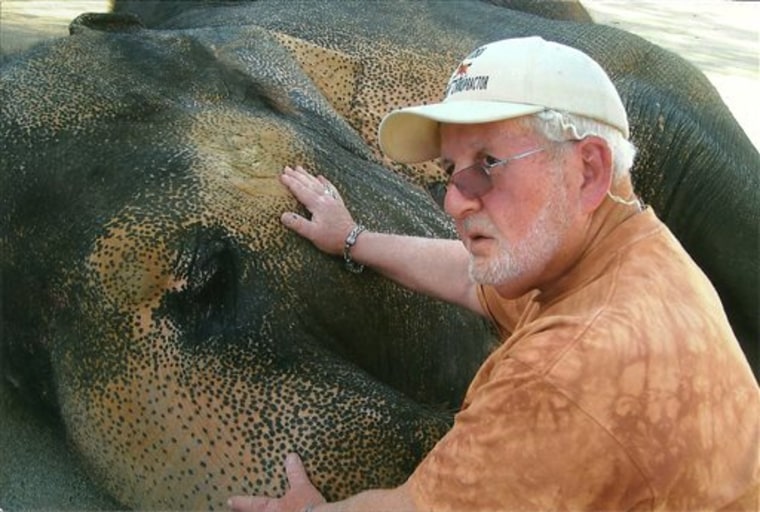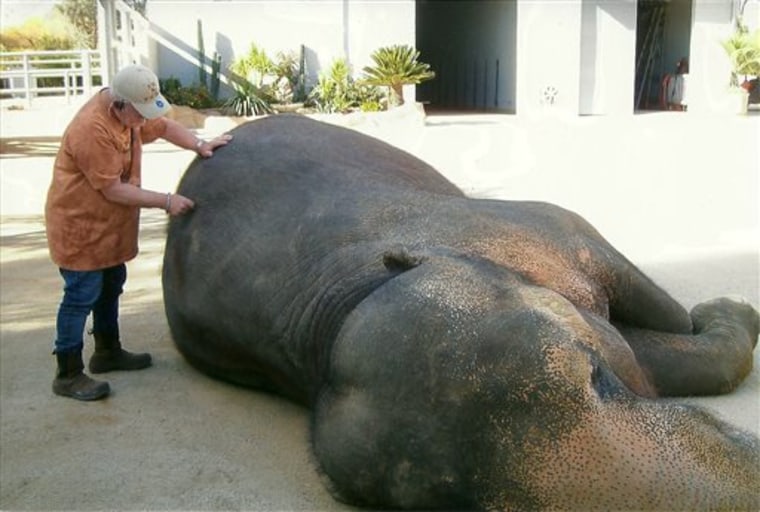Thirty years ago, Dr. Gene Giggleman was a veterinarian who thought chiropractors were quacks. Since then, he says he's straightened out thousands of dogs and cats, not to mention the occasional snake, hamster, gerbil and guinea pig.
"And I know people who have adjusted pigs, goats and rodeo bulls," said Giggleman, a professor at Parker University in Dallas, which specializes in chiropractic care.
In Southern California, Dr. Rod Block has tended to an elephant, a paralyzed iguana, a turkey, pigs, llamas and countless dogs and horses.
"You have to be very much in tune with the being of the animal you are working with," said Block, who limits his work these days to house calls throughout Southern California, where he works with several veterinarians.
"A chiropractor promotes the flow of energy within the body. Anywhere there is an obstruction or blockage of energy due to subluxation or a dysfunctional group of muscles, what the chiropractor does is normalize that function," Block said.
Giggleman spends most of his time teaching but still sees patients one day a week. Ninety percent of his patients need chiropractic care and 10 percent need traditional care, he said.
"I'm not an extremist either way. I am for whatever fixes your dog," he said.
The vets say any human or animal with a spine-related problem can benefit from an "adjustment."

Unlike Giggleman, who started as a veterinarian, Block spent 30 years as a human chiropractor before he switched gears 20 years ago and became certified by the Bluejacket, Okla.-based American Veterinary Chiropractic Association.
Classes take about a year of extra study, Block said.
The AVCA has certified over 1,000 veterinarians or chiropractors since 1989, said Leslie Means executive director of the group. There are 560 active members today and they have to be recertified every three years.
However, the certificates are not licenses to practice medicine. In states like Nevada and Oklahoma, getting a certificate is the only way you can set up shop. But states like California and Texas require those with certificates to work under the supervision of a veterinarian.
As a result, in many states, veterinarians and animal chiropractors work out of the same offices. They can make referrals to one another and even merge their telephone and online listings.
"We are more concerned about the quality than the quantity of life," Block said. One of his patients is a 38-year-old horse, owned by a veterinary professor. "He's not rideable, but he's mobile. He's off steroids and free to roam around and enjoy the remainder of his life relatively pain-free," Block said.
The horse doesn't get top billing in his new book though. "Like Chiropractic for Elephants" describes how he treated a gimpy elephant at a private sanctuary, how her herd accepted him and how she used body language to help him find her pain.
Through the book, Block said he hopes "to demystify chiropractic. People think that it's dangerous and that it's quackery. I really want to illuminate the differences between what allopathic (mainstream) veterinary medical care does and what chiropractic does and how the two integrate well even though they are at opposite ends of the pole.
"Above all, I want people to become more aware of the relationships they have with their animals, which I think is evolving," he said.
The story of Giggleman's first chiropractic success is included in "Chicken Soup for the Chiropractic Soul."
Sparky, a cocker spaniel, appeared to be having seizures, was on three drugs from three different vets and was going to be euthanized if Giggleman couldn't help him.
"I examined the dog. Although I was a fledgling, I could tell the dog's neck was out of whack or subluxated," he said. "When I reached down and petted the dog, it hurt him so bad, he flipped over and started shaking."
Giggleman adjusted Sparky and the dog lived another six years without seizures, he said.
On the spot, that made a convert out of Giggleman. He went on to co-found the Parker University animal chiropractic program.
"Chiropractic care is a drugless, non-surgical approach to treating animals," Giggleman said. And, he added, much cheaper than traditional medicine with its surgeries and drugs.
Leslie Means, the AVCA director, had a show dog, an 85-pound Siberian husky who was trained in hand signals. "She misread a signal and jumped off the front porch. There was a 10-foot drop," she said. X-rays were negative for broken bones but the dog cried constantly.
After seeing six vets and finding no relief for the dog, Means found the nearest animal chiropractor and made an appointment.
Means drove eight hours to get there, but after the appointment, the dog walked out of the office and jumped into the back seat of the car without so much as a whimper.
When Giggleman started teaching a course on how to adjust animals over a decade ago, the bulk of his students were chiropractors. "Now, for the first time, we are seeing more veterinarians than chiropractors," he said.
"There is no cure-all discipline," he said. "Chiropractic is complimentary care. There are times when pets need surgery."
Animals often get more out of chiropractic care than humans, he said.
"Animals don't lie. They are either better or not. They are very demonstrative with their adjustments. They don't have all the mental trash we deal with on a daily basis. They hold their adjustments better because they don't have all the stress we have."
Pet owners know when their animals need an adjustment, Giggleman said. "If you pay attention, you can tell something is wrong. There is a slang term we use in Texas — somebody will come in and say, 'He's ADR.' That means, 'Ain't doin' right, Doc,'" he said.
Giggleman teaches full-time and is semi-retired after 31 years of practice, but he sees patients one afternoon a week.
About once a month, a pet owner will come in and tell him: "If you can't do anything, I will have to put my pet to sleep."
He said he's able to save 80 percent of those animals. For the others "we get the animals out of some of the pain they are in and help the owners work through the whole issue as they prepare to part with their beloved pets."
There is a double blessing for those he saves, Giggleman said, "because not only are you making the pet better, but saving a life."
